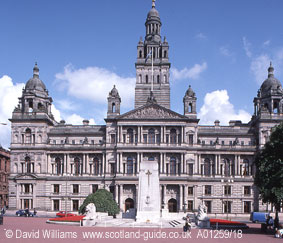The City Chambers (1882-90, William Young) dominates the eastern end of George Square. This is the seat of local government and is the city`s most finely decorated building. It was built to reflect Glasgow`s proud boast of being `The Second City of the Empire` and the magnificent exterior and interior attests to the wealth the city possessed at the end of the nineteenth century.
The building`s entrance is based on the third-century Arch of Constantine in Rome which the architect, William Young, had visited before preparing the plans. Young wrote a book about the building in which he explained that:
here a similar display of art in stone (by Mr G. A. Lawson, who also executed the sculptured pediment) declares the peaceful victories of art, science, and commerce. Over the key-stone of the centre arch is a representation of the city coat of arms, with the motto `Let Glasgow flourish`; and to this the sculptured subjects add for supports - By the aid of Religion, Virtue, and Knowledge.
The figures
supporting the coat of arms on both sides represent Religion, the emblems
being victory and glory. The other figures in the central arch symbolize
the Virtues - Faith, Hope, Truth, Charity. The sculptured band continuing
to the left over the side arch represents the Art, Knowledges, Architecture,
Sculpture, Painting, Music, Oratory, Literature; while on the other side
are figures representing Astronomy, Geology, Chemistry, Engineering, and
the Healing Art - all bringing their respective knowledge to support the
central motto, `Let Glasgow flourish.`
More information on the upper storeys.
Further details about the building can be found in "The Glasgow Guide".
This article is based on the guidebook "The Glasgow Guide".

The City Chambers is well-known for its imposing frontage but it also has some of Glasgow`s best (and most flamboyant) interior decoration.
Just inside the main door, the Loggia has a patterned vaulted ceiling which features one-and-a-half million individual pieces of Venetian mosaic. Farther inside, the building has two open staircases and the grander of the two (the Marble Staircase) rises the full three storeys of the building. The grand Banqueting Hall is on the second floor and on its walls are hung paintings illustrating the hisory of the city.